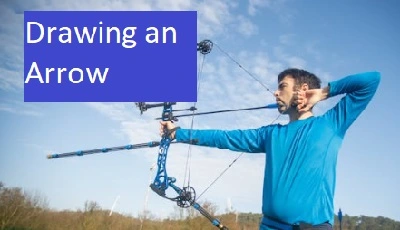- Best Archery Accessories 2024 - March 19, 2022
- Bow string:Why does it keep hitting my arm? - February 2, 2022
- Bow square: A how to guide - February 2, 2022
You have your archery bow in your hand but finding it difficult to draw it the correct way. What should you do to get a faultless draw?
The best way to shoot an arrow the most productive and detail way is to get the right shot sequence first. Therefore, if you are ready to enhance your skill, check out all the ten steps discussed here!
Ten Important Pre-Steps you Need to Think About
Before you get the best compound or recurve-bow draw, you need to consider the following pre-steps:
Step One
Start by determining your dominant eye or eye preference. The term is an inclination to use visual input from your one eye instead of the other one.
Think about it this way if you are right-handed you use that hand to do different tasks while left-handed archers use the left side.
The same applies to use your eyes as some shooters are right-eye dominant and focus on objects with the right eye. The same applies to left-handed shooters.
To aim correctly in archery, you need to use your dominant eye. You may even find you are cross dominant as well using both eyes.

So how do you find out what is your dominant eye? You can do the following:
- Place your hands in front of your body with the palms facing forwards, making a stop gesture sign.
- Now bring the thumbs together touching each other.
- Take your hands and turn the angle so that the pointer finger is touching making it able for you to see a triangle shape.
- Bring the hands closer together, making the triangle smaller but still big enough for you to see through it.
- Now, look through the triangle at an object about 15 yards away-it can be anything but small to see it clearly through the triangle.
- Close your left eye and then close the right one. What happens is that you will see an image displayed of the object through the one and not the other eye when closed.
- Depending on the eye, you see image whether right or left it is your dominant eye to use when aiming.
Step Two
One of the overlooked aspects of archery is to have a correct bow stance. While there are a few stances to try, we recommend you start with a square stand that works best for beginners.
Furthermore, we recommend you do this a couple of times without your bow to get a feel of the position.
- Feet – set up a shooting line at your range and place your feet on both sides of this line. For the right-handed, the left foot is the front foot, and right-foot is the front foot for left-handed. Now shuffle the feet until shoulder-width apart and parallel with the shooting line. Now it is time to relax in this position.
- Knees – bend the knees slightly and prevent them from locking as it makes you unstable and not able to control the shot.
- Hips – make sure the hips are facing forward while breathing normal and relax.
- Lower Back – keep the lower back flat as keeping it arched can lead to injuries.
- Torso – your torso should face straightforward (perpendicular) to the shooting line and target. Stand up straight without puffing the chest out and do not lean forward as it will mess up the shot.
- Shoulders – relax the shoulders should not be drawn up high.
- Head – now that you have done all of the above, keep looking straightforward. For the right-handed, the torso needs to be kept forward, but you need to turn the head left to see the target. Left-handed shooters keep the body ahead with the head turned right.
Step Three
Now it is time to knock your arrow. Reach into the quiver to grab an arrow in the front of the fletching.
The shaft comprises of three groupings of vanes with one having a unique color called the index feather. Make sure your bow is pointing towards the ground.
Furthermore, make sure the bow limbs vertical and set the arrow rest. For the recurve bow you need to make sure, the feather is pointing away from your bow.
For compound bows, the index vane can point up and depends on the type of arrow rest you use. Now the arrow is on the rest, start by clicking the nock at the end of the shaft into your bowstring.
You may not hear the clicking but should be able to feel it sitting secure onto the string. The important thing is to sense that it is securely attached if not, you did not correctly connect it.
Step Four
Now it is time to grasp the string of the bow:
- With your protective gear on to prevent accidents place the first joint of your fingers on the line.
- Place the pointer finger above the shaft with the middle and ring finger below it.
- Your thumb will be down and relaxed without sticking up or out while the pinky is out of the way to relax.
Step Five
With a calm and relaxed grip, it is time to ready your bow hand by fully grasping the bow.
Step Six
Now you need to raise the bow to the target with your bow arm. Always remember to keep the shoulders relaxed and your arm steady.
Step Seven
Now that you have completed steps one to six, it is time to draw the bow. Bring the bowstring towards the side of your face in a backward position.
However, there are essential things to keep in mind during the draw:
- Always keep your head up straight
- Keep the shoulders relaxed
- Use your back and arms when at full draw by squeezing both the shoulder blades together gently.
- Keep your wrist flat and the string centered as you draw.
- During the full draw, keeps the chest facing the target with the index finger close to the corner of your mouth. Furthermore, keeps the elbow of your draw arm remaining directly behind the arrow to be parallel with the shaft.
- Keep things smooth with a continuous motion to pull back from the at-rest position of the bow.
Step Eight
In the position, find your anchor point when pulling the bowstring back. Once it comes close to the face, the anchor point is the spot on your face that the bowstring hand should touch when at full draw.
Step Nine
Here we have the most critical step, and that is to aim by either using a bow sight or doing instinctive shooting without an optic.
Step Ten
Now it is time to let go with a dynamic release with all your muscles feeling the let go of the arrow. Once you complete the shot, it is time to revise what when wrong.
Other Considerations
While these steps help you to make a perfect draw, other things play a significant role before drawing your archery bow:
The Correct Draw Weight:
It helps if you had an appropriate draw weight and is one of the essential parts of the draw. The draw weight force you measure in pounds.
Therefore, if you nock the arrow and pull it back on the bowstring using a bow comprising a draw weight of 20-pounds, the fact is that it will be easier than nocking the shaft when pulling back the bowstring of a bow with the 50-pound draw weight.
The important thing is not to use a bow with a draw weight that is too low, as the arrow will not travel accurate or fast. Furthermore, if the bow draw weight is too high, you may find it challenging to draw the line causing injury to yourself.
So to answer what is the best draw weight for a recurve bow, the best one to choose is one with a draw weight ranging from 15 – 70 lbs. However, the most common ones are 25 lbs to 35 pounds.
Still, on the subject of the draw weight, how do you measure and adjust the draw length?
How to measure draw length?
You can do this by standing with your back to the wall while stretching out your arms against the wall. Now you measure the distance from the end of the middle finger to the other end of your middle finger. The calculations will include the measurements from the length of both arms, chest, and hands once you have the dimension divide it by two to get the draw length.
How do you adjust the draw length?
Depending on the bow you use there are specific cam bow who work with particular cams providing you with different draw lengths.
Therefore, you need to buy the correct cam that is either alpha or numerically marked to install on the bow to change the draw length.
If you care for your compound bow properly, you need to have it pressed by a qualified person at a local pro shop. On the market, you can find:
- Adjustable cams
- Draw length specific cams
Conclusion
Archery is an athletic event that is the same as any other sports. It helps if you worked those upper body muscles for extra power to be able to draw an archery bow successfully. By following the above steps, training, and diligent practice you can become an excellent archer or bowhunter.
